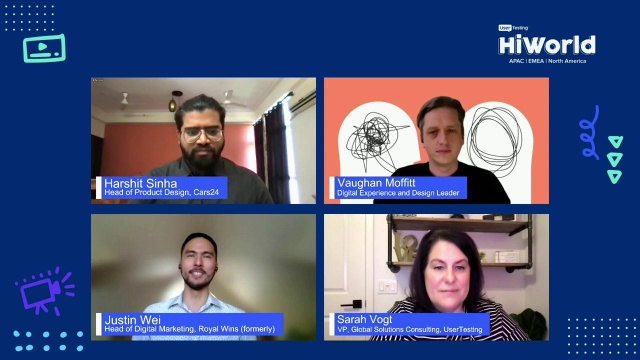
Who benefits from human insight?

It’s no secret that professionals are being asked to do more with less as the demand for output increases. Regardless of your position, one of the most effective paths to success is being closely aligned with your customers and target audiences.
The truth? Anyone in an organization can benefit significantly from human insight because understanding your customers better means doing better work and making better decisions.
Here are some specific ways human insight helps organizations and the people within them.
What do we mean by human insight?
De-risk your department
Teams are designing, building, and iterating products and experiences faster than ever to adapt to customers, beat the competition, and survive. As a result, many professionals are forced to make decisions in the dark. They rely only on quantitative data or gut instinct alone, which introduces massive risk and costly rework to their department.
When you use qualitative and quantitative insight together, it’s like a black-and-white TV suddenly projecting in color. While quantitative data is foundational to understanding what’s happening, qualitative data introduces a new dimension of why something is happening—straight from the mouth of the people it’s happening to.
Hear how Justin Wei uses quantitative and qualitative data together.

When we get insights from both types of data and share them across departments so that everyone is aligned, it reduces risk to the organization. Empowering teams to connect with key target audiences to validate strategic or tactical initiatives helps them gain confidence in their priorities and resource allocation.
Ask yourself: How long does it take to get customer insight today?
If you’re questioning whether you would benefit from fast and accurate human insight, think about the last time you wished you could have known something before making a decision or working on a project. Have you ever had a question about the best way forward but no way to ask? Or have you been in a situation where asking your research team for insights would have taken too long?
One of the biggest predictors of customer experience success is customer exposure hours, or spending at least two hours every six weeks observing customers. If you're not meeting this benchmark, it's time to start looking into how to get closer to customers and target audiences.
Get more customer-centric
Creating a culture of customer empathy helps drive best-in-class customer experiences. When teams are empowered to make better decisions, they drive continuous innovation with fast, quality human insights.
Accessibility and inclusivity
Each design decision made during a project can potentially exclude different types of people. Customer-centric organizations maintain an awareness of this danger and emphasize inclusivity within their products. In a design cycle, inclusivity requires a relentless focus on accessibility throughout the user experience.
Accessibility is about ensuring all customers and users can access the products and services your organization makes available to them, including those physically disabled or neurodivergent.
No one team is responsible for accessibility. The organization’s holistic effort requires collaboration and testing from product, development, and design teams. Accessibility testing is a multifaceted process, including design and code reviews. Thankfully, accessibility has become a hot topic in design. Some organizations are required by law to ensure the accessibility of their products and services.
Of course, it isn’t always possible to design a product that serves the needs of everyone, and it wouldn’t be fair to expect that. Nevertheless, genuinely customer-centric organizations intentionally work to design experiences that respond appropriately to diversity in the population. The goal is to create products that are usable by as many different types of people as reasonably possible. That could mean creating a family of products for different population segments or simply improving usability so the product is easy to understand for different levels of cognitive ability.
How to create and measure digital accessibility
Seniorities that benefit from human insight
All seniorities at an organization can reap the benefits of either gaining access to human insight or helping their teams gain access. Let's break them down.
Executives
It’s no secret that executives play a critical role in creating a customer-centric organization. While market share and consumer habits aren’t things your teams can control or predict, making customers the priority is. When executives give their teams fast access to human insight and focus the organization on the customer, they can make customer-informed decisions to drive growth and reduce risk.
This prevents product and marketing teams from guessing how they think a customer will react to a new product or feature—without any insight to back it up. After all, relying on hunches and making assumptions rarely works out well. With the speed of business today, a single bad decision can lead to precisely what executives want to avoid: wasted time, lost budget, and the outright failure of a product or campaign.
Managers and leaders
Hearing directly from customers is one of the most powerful motivators for a customer-obsessed company. Whether you’re sharing with a colleague, your team, or the entire company, it’s important to highlight what you’ve discovered by interacting with customers.
Individual contributors
Customer centricity becomes part of an organization’s DNA when individual contributors (ICs) feel empowered to answer questions and solve problems through testing. Once ICs start to see how helpful customer insight platforms and testing tools can be, they can creatively apply them to more scenarios in their work life. This helps them do their job more quickly and confidently while ultimately having a positive impact on the organization as a whole.
Departments that benefit from human insight
Many different departments and roles will benefit from gaining direct access to human insight. Here are a few:
Agencies
With the budget scrutinized, more agencies are asking for end-user feedback. Clients want to feel confident that they’ll see results before they throw money at a problem. As an agency, having a deep understanding of your client’s organization is essential. You want to know things that they don’t.
Agency teams can make faster, better-informed client proposals using a human insight platform to get a look under the hood. This empowers them to submit hyper-relevant RFP responses after uncovering an account's real needs and challenges.
Digital product teams
When organizations are asked to do more with less, teams feel rushed to design, build, and iterate on products and experiences. When digital product teams are forced to make uninformed decisions at each phase of the development process to keep pace with the organization, they need timely customer insight, relying only on quantitative data or their gut instinct. This introduces risk into an organization and results in failed initiatives, costly rework, and churn.
To reduce the risk of building something no one wants and staying competitive, digital product teams can champion human insight as the most valuable step in their product development process. This may require a bit of a shift in thinking on the part of teams, stakeholders, and executive leadership, but it’s worth the growing pains.
Human resources teams
Overstretched HR teams have now become the norm. With the rise of employees wanting a company culture that aligns with their values and supports them through all their life moments, organizations are rethinking their current people structure to place employees at the center of decision-making.
Direct and current feedback is one of the most impactful ways to do this. There are many opportunities for HR professionals to gain feedback, whether through engagement, benefits, or performance reviews, to name a few. But typically, the only time feedback is received on HR programs or protocol is during the annual engagement survey at a specific time. This type of feedback is reactive and usually comes in too late to make a measurable difference in adjusting current programs or removing any negative feelings harbored from a poor experience.
So, how can HR teams take a more proactive and innovative approach to understanding their employee’s needs and ensure they’re on the right track—before a program is launched? This will cover common HR pitfalls and issues you may run into and different methods of including your employees’ perspectives.
Marketers
In today’s fast-moving world, marketers need to adapt in real time to the constant change in customer behaviors, preferences, and needs. To drive growth and stay one step ahead of the competition, marketers must go beyond data to understand what motivates customers to take action—and how perceptions, expectations, and emotions play a role in the decision-making process.
Unfortunately, marketers don’t get regular audience feedback, and they’re expected to work quickly. This leaves marketers little time to make decisions, often forcing them to rely on hunches gleaned from historical data and trends. Although analytics can help, they can’t explain what customers think, let alone what they need. That’s essential information. To capture these actionable insights, marketers often turn to traditional market research that takes too long and costs too much.
When marketers have access to fast human insight, they can make decisions centered around feedback from their target audience to drive growth, lower costs, and reduce the risk that the next campaign will be a flop.
UX designers
Design sprints are one of the fastest ways to help design teams answer critical business questions using design thinking and customer validation. When teams incorporate on-demand customer research during sprints, they can quickly gather valuable insights that inform design decisions while helping expose a team to design thinking and rally an entire organization around the customer.

Want to learn more?
Bring customer perspectives into more decisions across teams and experiences to design, develop, and deliver products with more confidence and less risk.


